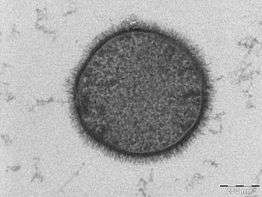Ultrastructure

Ultrastructure (or ultra-structure) is the nanostructure of a biological specimen, such as a cell, tissue, or organ, at scales smaller than can be viewed with light microscopy. It is viewed with ultramicroscopy or electron microscopy. Such cellular structures as organelles, which allow the cell to function properly within its specified environment, can be examined at the ultrastructural level.
Ultrastructure, along with molecular phylogeny, has often been a reliable (that is, phylogenetic) way of classifying organisms.[1]
References
- ↑ Laura Wegener Parfrey; Erika Barbero; Elyse Lasser; Micah Dunthorn; Debashish Bhattacharya; David J Patterson & Laura A Katz (December 2006). "Evaluating Support for the Current Classification of Eukaryotic Diversity". PLoS Genet. 2 (12): e220. doi:10.1371/journal.pgen.0020220. PMC 1713255
 . PMID 17194223.
. PMID 17194223.
This article is issued from Wikipedia - version of the 8/15/2016. The text is available under the Creative Commons Attribution/Share Alike but additional terms may apply for the media files.